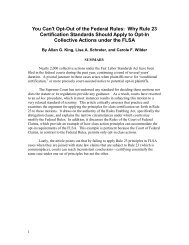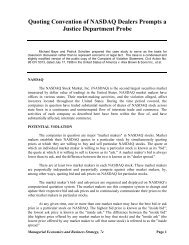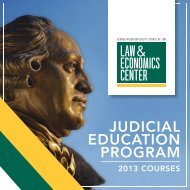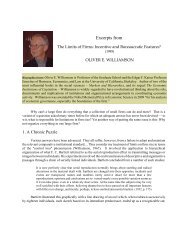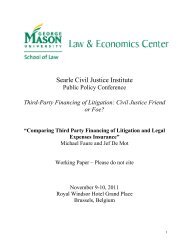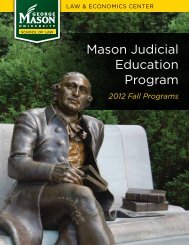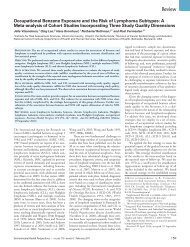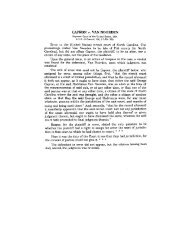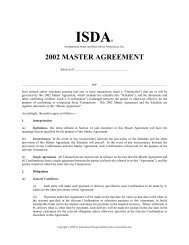Pelman v. McDonald's Corp. - Law & Economics Center
Pelman v. McDonald's Corp. - Law & Economics Center
Pelman v. McDonald's Corp. - Law & Economics Center
Create successful ePaper yourself
Turn your PDF publications into a flip-book with our unique Google optimized e-Paper software.
<strong>Pelman</strong> v. <strong>McDonald's</strong> <strong>Corp</strong>., Slip Copy (2010)2010 WL 4261390Only the Westlaw citation is currently available.United States District Court,S.D. New York.PELMAN, et al., Plaintiffs,v.McDONALD'S CORP., Defendant.No. 02 Civ. 07821(DCP) 1 . Oct. 27, 2010.[Plaintiffs' motion for class certification and, in thealternative, issue class certification is denied.]Attorneys and <strong>Law</strong> FirmsSamuel Hirsch & Associates, P.C. (Samuel Hirsch), forPlaintiffs.Winston & Strawn LLP (Thomas J. Quigley, Bradley E.Lerman, Bruce R. Braun, Scott P. Glauberman, Melissa A.Gabriel and Thomas P. O'Connor), for Defendant.OpinionOPINION AND ORDERDONALD C. POGUE, District Judge.*1 Pogue, Judge: Plaintiffs in this action are New YorkState consumers claiming, pursuant to Section 349 of NewYork's General Business <strong>Law</strong> (“GBL § 349”), exposureto and injury from Defendant <strong>McDonald's</strong> <strong>Corp</strong>oration'sallegedly deceptive marketing scheme. Plaintiffs claim thatthe effect of Defendant's affirmative representations andmaterial omissions throughout this marketing scheme-from1985 until the filing of this case in 2002-was to misleadconsumers into falsely believing that Defendant's foodproducts may be consumed on a daily basis without incurringany adverse health effects, and that, as a result of thismarketing scheme, Plaintiffs and putative class memberssuffered injury in the form of, inter alia, the development ofcertain adverse medical conditions. The court has jurisdictionover this action pursuant to 28 U.S.C. § 1332 (2000).Before the court is Plaintiffs' motion for class certificationpursuant to Federal Rule of Civil Procedure 23(b)(3) or,in the alternative, for class certification solely with respectto the litigation of issues common to all putative classmembers, pursuant to Rule 23(c)(4). As explained below,because establishment of the causation and injury elementsof Plaintiffs' claims will necessitate extensive individualizedinquiries, the court finds that the questions of law and factwhich would be common to putative class members wouldnot predominate over questions affecting only individualmembers. Accordingly, certification of this action for classlitigation under Rule 23(b)(3) is not appropriate. SeeFed.R.Civ.P. 23(b)(3).Moreover, class certification under Rule 23(c)(4) is notappropriate at this time. Although Plaintiffs' claim containsissues which may be common to potential class members,the resolution of which is susceptible to proof by commonevidence on the basis of objective standards, there isinsufficient evidence to establish the existence of a class ofpersons who hold identical claims, on the basis of identicalinjuries, to those allegedly suffered by Plaintiffs-i.e., theevidence presented is not sufficient to satisfy the numerosityrequirement of Rule 23(a)(1). See, e.g., Charron v. PinnacleGr. N.Y., --- F.R.D. ----, No. 07 Civ. 6316(CM)(RLE), 2010WL 1752501, at *19 (S.D.N.Y. Apr. 27, 2010) (issue classescertified under Rule 23(c)(4) must satisfy the criteria of Rules23(a) and (b) with respect to the issues certified).The court therefore denies Plaintiffs' motion for classcertification in its entirety.A. Procedural HistoryBACKGROUNDPlaintiffs originally commenced this suit in the StateSupreme Court of New York, Bronx County, on August22, 2002. Plaintiffs claimed that Defendants <strong>McDonald's</strong><strong>Corp</strong>oration, <strong>McDonald's</strong> Restaurants of New York, Inc.,<strong>McDonald's</strong> 1865 Bruckner Boulevard Bronx, New York,and <strong>McDonald's</strong> 2630 Jerome Avenue, Bronx, New York(collectively “<strong>McDonald's</strong>”) engaged in deceptive businesspractices in making and selling their products, and that“this deception has caused the minors who have consumedMcDonald[']s' products to injure their health by becomingobese.” <strong>Pelman</strong> v. <strong>McDonald's</strong> <strong>Corp</strong>., 237 F.Supp.2d 512,516 (S.D.N.Y.2003) (“<strong>Pelman</strong> I” ).*2 <strong>McDonald's</strong> removed the action to this Court onSeptember 30, 2002, alleging that Plaintiffs had fraudulentlyjoined non-diverse parties to defeat diversity jurisdictionunder 28 U.S.C. § 1332. By opinion of January 22, 2003, thecourt denied Plaintiff's motion to remand back to the SupremeCourt of New York, <strong>Pelman</strong> I, 237 F.Supp.2d at 521-23,© 2010 Thomson Reuters. No claim to original U.S. Government Works. 1
<strong>Pelman</strong> v. <strong>McDonald's</strong> <strong>Corp</strong>., Slip Copy (2010)concluding that “there is no reasonable basis, based on thepleadings, for liability against the non-diverse defendants inlight of the claims alleged.” See id. at 521 (citation omitted);523 (“Clearly what is at issue in this lawsuit is the nationalmenu and national policy of <strong>McDonald's</strong> <strong>Corp</strong>., and theplaintiffs' real beef is with <strong>McDonald's</strong> <strong>Corp</strong>.”). 2Having satisfied itself of jurisdiction, the court, by the sameopinion of January 22, 2003, granted Defendant's Rule 12(b)(6) motion to dismiss all counts of Plaintiffs' complaint forfailure to state a claim upon which relief may be granted, id. at524-43, but granted Plaintiffs leave to amend their complaint.Id. at 543.Plaintiffs filed their first amended complaint (“FAC”) onFebruary 19, 2003. On September 3, 2003, the courtagain granted Defendant's renewed Rule 12(b)(6) motion,dismissing Plaintiffs' complaint in its entirety, without leaveto amend. <strong>Pelman</strong> v. <strong>McDonald's</strong> <strong>Corp</strong>., No. 02 Civ.7821(RWS), 2003 WL 22052778, at *14 (S.D.N.Y. Sept. 3,2003) (“<strong>Pelman</strong> II” ). 3Plaintiffs appealed solely the district court's dismissal ofcounts I, II and III-each brought under GBL § 349 4 -of theirFAC. <strong>Pelman</strong> v. <strong>McDonald's</strong> <strong>Corp</strong>., 396 F.3d 508, 509-11(2d Cir.2005) (“<strong>Pelman</strong> III” ). 5 The United States Court ofAppeals for the Second Circuit (“Second Circuit”) vacatedthe district court's dismissal of these claims, holding that,“because a private action under [GBL] § 349 does not requireproof of the same essential elements (such as reliance) ascommon-law fraud, an action under [GBL] § 349 is notsubject to the pleading-with-particularity requirements ofRule 9(b), Fed.R.Civ.P., but need only meet the bare-bonesnotice-pleading requirements of Rule 8(a), Fed. R. Civ. P,”id. at 511 (citations omitted), and that “[s]o far as the [GBL]§ 349 claims are concerned, the [FAC] more than meets therequirements of Rule 8(a).” Id. at 512 (footnote omitted).Following a remand to this Court for further proceedingsconsistent with the Second Circuit's opinion in <strong>Pelman</strong>III, see <strong>Pelman</strong> III, 396 F.3d at 512, the court grantedin part Defendant's Rule 12(e) motion for a more definitestatement, requiring Plaintiffs to “identify the advertisementsthat collectively amount to the alleged deceptive nutritionalscheme.” <strong>Pelman</strong> v. <strong>McDonald's</strong> <strong>Corp</strong>., 396 F.Supp.2d 439,445 (S.D.N.Y.2005) (“<strong>Pelman</strong> IV” ). In addition, the courtrequired Plaintiffs to provide “a brief explanation of whythe advertisements are materially deceptive to an objectiveconsumer.” Id. 6 In addition, “in accordance with GBL §349's requirement that [P]laintiffs' injuries be ‘by reasonof’ [D]efendant's conduct, the court directed Plaintiffs [to]provide a brief explanation of how [P]laintiffs were aware ofthe nutritional scheme[ ] they allege to have been deceptive.”Id. at 446 (citing Stutman v. Chem. Bank, 731 N.E.2d 608, 612(N.Y.2000)). 7 The court also required Plaintiffs to “outlinethe injuries that were suffered by each plaintiff ‘by reasonof’ defendant's alleged deceptive nutritional scheme.” Id.(quoting N.Y. Gen. Bus. L. § 349). 8*3 Plaintiffs filed their second amended complaint (“SAC”)on December 12, 2005. By opinion of September 16, 2006,the court denied Defendant's motion to strike and dismiss theSAC for failure to comport with the court's orders in <strong>Pelman</strong>IV. <strong>Pelman</strong> v. <strong>McDonald's</strong> <strong>Corp</strong>., 452 F.Supp.2d 320, 328(S.D.N.Y.2006) (“<strong>Pelman</strong> V” ). 9 The court noted that:the SAC identifies a number of advertisements being claimedas part of the Defendant's deceptive practices[;] ... outlineswhy the advertisements are objectively deceptive[;] ... allegesthat Plaintiffs were aware of <strong>McDonald's</strong> deceptive practicesthrough their exposure to the advertisements and statementsannexed to their pleading and that such statements weredisseminated in the specified fora of[ ] television, radio,internet, magazine, periodical, in-store poster advertisements,and press releases issued in New York State from 1985 andcontinuing through filing in 2002[;] ... [and] alleges thateach named Plaintiff was injured as a result of Defendant'spractices, in the following respects: obesity, elevated levels ofLow-Density Lipoprotein, or LDL, more commonly knownas ‘bad’ cholesterol [“LDL”], significant or substantialincreased factors in the development of coronary heartdisease, pediatric diabetes, high blood pressure, and/or otherdetrimental and adverse health effects and/or diseases asmedically determined to have been causally connected to theprolonged use of Defendant's products[ ].Id. at 323 (citing SAC 558, 564, 570, 576, 582, 588, 594,600, 617, 623, 629, 635, 641, 647, 653, & 659). The courtthen held that, because “Plaintiffs need not have seen or heardeach advertisement, but rather only to have been exposed tothem in some manner,” id. at 324 (citing <strong>Pelman</strong> IV, 396F.Supp.2d at 445-46), the SAC sufficiently described howPlaintiffs were aware of the marketing scheme alleged to bedeceptive, id. at 325, and that, “[c]ontrary to <strong>McDonald's</strong>contentions, ... the SAC outlines the injuries sustained by eachPlaintiff in a manner sufficient for <strong>McDonald's</strong> to answer.”Id. at 326.© 2010 Thomson Reuters. No claim to original U.S. Government Works. 2
<strong>Pelman</strong> v. <strong>McDonald's</strong> <strong>Corp</strong>., Slip Copy (2010)and because there is no evidence to suggest that all whoconsume such foods develop the kinds of medical conditionswhich are at issue in this case, the central proposition uponwhich Dr. Barnard's argument is based necessarily admitsthe conclusion that, in the absence of individualized inquiriesregarding various other factors, no necessary generalizablecausal connection is manifest between the consumption ofDefendant's products and the development of certain medicalconditions. 28Dr. Frieden, whose declaration in a prior action 29 isalso submitted in support of Plaintiffs' motion for classcertification (Pls.' Mot. for Class Cert. Ex. C (“FriedenDecl.”)), similarly presents no evidence establishing adirect and necessary causal connection, obviating the needfor individualized inquiries, between the consumption ofDefendant's products and the development of the sort ofmedical conditions allegedly suffered by Plaintiffs. (See, e.g.,id. at 9 (“People who are overweight are at increased risk fordiabetes, heart disease, stroke, high blood pressure, arthritis,and cancer.” (emphasis added)). 30 ) Because, as Dr. Friedenpoints out, “increasing weight results from an imbalancebetween calories consumed (nutrition) and energy expended(physical activity)” (Frieden Aff. 14), individualizedinquiries predominate in this case regarding the extent of eachplaintiff's consumption and energy expenditure.The court therefore concludes that, because factual questionswith regard to, at the very least, the nutritional compositionof food products consumed by each plaintiff from sourcesother than Defendant's facilities, as well as the level of regularphysical activity engaged in by each plaintiff, predominate inthe inquiry with respect to an essential element of Plaintiffs'cause of action, this case is not appropriate for adjudicationon a class-wide basis. 31 See, e.g., Yeger v. E*Trade Sec. LLC,884 N.Y.S.2d 21, 24 (N.Y.App.Div.2009) (decertifying class,despite a common question as to the wrongfulness of thedefendant's conduct, because “this is only half the question,”and whether the defendant's conduct “caused an individualclass member to suffer actual damages depends upon facts soindividualized that it is impossible to prove them on a classwidebasis”).*9 Moreover, Defendant is correct that whether or notPlaintiffs' claims-that they ate <strong>McDonald's</strong> food becausethey believed it to be healthier than it was in fact-are truefor any particular person is an inquiry which also requiresindividualized proof. (<strong>McDonald's</strong> Mem. of <strong>Law</strong> in Supp.Mot. to Strike Class Allegations & Deny Class Cert. (“Def.'sMem. in Opp'n Class Cert.”) 13.) See, e.g., Newman v. RCNTelecom Servs., Inc., 238 F.R.D. 57, 63 (S.D.N.Y.2006) (“Tosustain a claim under GBL § 349, [ ] the alleged deceptive actmust be the cause of the harm asserted.”); Whalen v.. Pfizer,Inc., 862 N.Y.S.2d 812 (N.Y.Sup.Ct.2005) (Table) (“[T]osatisfy the commonality requirement in a class action allegingdeceptive acts and practices [under GBL § 349] ..., the proofmust show that each plaintiff was reasonably deceived bythe defendant's misrepresentations and was injured by reasonthereof .” (emphasis in original)).As Defendant points out, “[a] person's choice to eat at<strong>McDonald's</strong> and what foods (and how much) he eatsmay depend on taste, past experience, habit, convenience,location, peer choices, other non-nutritional advertising, andcost” (Def.'s Mem. in Opp'n Class Cert. 13 (citing Def.'s Mot.to Strike, Aff. Timothy P. Meyer (“Meyer Aff.”) 2, 4-9,18), and although “[b]eliefs about nutrition may influence aperson's decision in some cases, [it will] not always [be thecase].” (Id. (citing Meyer Aff. 26).)Thus, in addition to individualized inquiries regarding thecausal connection between the consumption of products of acertain nutritional make-up and the development of certainphysical or medical conditions in particular plaintiffs, and inaddition to individualized inquiries regarding the extent towhich Defendant's establishments were the primary sourceof these types of products for each particular plaintiff,individualized inquiries will also predominate regardingthe causal connection between each plaintiff's exposure tothe allegedly misleading aspects of Defendant's advertisingscheme and each Plaintiff's subsequent consumption ofDefendant's allegedly injurious products. See, e.g., Naftulinv. Sprint <strong>Corp</strong>., 847 N.Y.S.2d 903 (N.Y.Sup.Ct.2007)(Table) (“[T]he inducement to purchase defendants' services[or products] cannot be inferred and is unique to eachclass member.” (citing Hazelhurst v. Brita Prods. Co.,744 N.Y.S.2d 31, 33 (N.Y.App.Div.2002)); Solomon, 777N.Y.S.2d at 54 (“Even assuming that all the members ofthe class saw the same advertisements, questions as towhether each individual was reasonably misled by thempredominate, given the alternative sources of informationabout [Defendant's product] that each may have had.”). 32Accordingly, the court concludes that, “[w]hile somecommon questions concerning [Defendant's nutritionalmarketing scheme] exist, individual questions aboutcausation would overwhelm them[,] [and therefore] Plaintiff[s'] Section 349 claim is not appropriate for classcertification.” In re Currency Conversion, 230 F.R.D. at 311.© 2010 Thomson Reuters. No claim to original U.S. Government Works. 6
<strong>Pelman</strong> v. <strong>McDonald's</strong> <strong>Corp</strong>., Slip Copy (2010)B. Class Certification for the Litigation of Certain IssuesPursuant to Rule 23(c)(4) Is Also Not Appropriate.*10 Having concluded that Plaintiffs' proposed Class failsto meet the predominance requirement for certification underRule 23(b)(3), the court will now consider Plaintiffs' requestto certify an Issue Class “for a determination of Defendant'sliability for its deceptive conduct on consumers under [GBL]§ 349.” (Pls.' Mem. Supp. Class Cert. 1.)“When appropriate, an action may be brought or maintainedas a class action with respect to particular issues.”Fed.R.Civ.P. 23(c)(4). Further, “a court may employ Rule23(c)(4) [ ] to certify a class on a particular issue evenif the action as a whole does not satisfy Rule 23(b)(3)'spredominance requirement.” In re Nassau Cnty. Strip SearchCases, 461 F.3d 219, 225 (2d Cir.2006). 33 “District courtsshould take full advantage of this provision to certifyseparate issues in order to reduce the range of disputedissues in complex litigation and achieve judicial efficiencies.”Robinson v. Metro-North Commuter R.R., 267 F.3d 147,167-68 (2d Cir.2001) (internal alteration and quotation marksand citations omitted) (holding issue-class certification to beappropriate where “litigating the pattern-or-practice liabilityphase for the class as a whole would both reduce the range ofissues in dispute and promote judicial economy”).“Issue certification is especially appropriate ... whereDefendants' liability can be determined once, on a class-widebasis, through common evidence.” Charron, --- F.R.D. at----, 2010 WL 1752501, at *23 (citation omitted). Moreover,where the initial elements of liability may be establishedon the basis of common evidence, issue certification maybe an appropriate method for advancing the litigation evenwhere the prevalence of individual inquiries regarding theelement of causation precludes class certification for theaction as a whole. Collins v. Olin <strong>Corp</strong>., 248 F.R.D. 95,104 (D.Conn.2008) ( “[I]ndividual issues of causation donot preclude class certification.... [A]lthough the element ofcausation may require more individualized proof, the proofas to the other elements of [the cause of action] will beclass-wide.” (citing Bates v. Tenco Servs., Inc., 132 F.R.D.160, 163-64 (D.S.C.1990) ( “Individual offers of proof ofproximate cause and damages for each plaintiff will becomean inevitable necessity; however, these individual questionsof proof will arise whether the suit proceeds individually or asa class action.”)) (footnote and additional citations omitted)).“For particular issues to be certified pursuant to Rule 23(c)(4), the requirements of Rules 23(a) and (b) must be satisfiedonly with respect to those issues.” Charron, --- F.R.D. at ----,2010 WL 1752501, at *19 (citing 5 Moore's Fed. Prac. §23.86[2] ).As mentioned, there are three elements to Plaintiffs' causeof action under GBL § 349: “first, that the challengedact or practice was consumer-oriented; second, that it wasmisleading in a material way; and third, that the plaintiffsuffered injury as a result of the deceptive act.” Stutman,731 N.E.2d at 611 (citations omitted). As explained above,Plaintiffs essentially challenge two aspects of Defendant'sadvertising scheme during the years between 1985 and 2002-the affirmative representation of Defendant's products asallegedly healthier than in fact, and the omission of materialinformation regarding the actual nutritional composition ofDefendant's products 34 -claiming that the medium of both therepresentation and the omission was consumer-oriented andmisleading in a material way, and that Plaintiffs and putativeclass members were injured as a result of these deceptive acts.(SAC 548-681.)*11 While the court has concluded that proof of the elementof injury as a result of the allegedly deceptive acts wouldrequire a level of individualized inquiry that precludes theclass-wide litigation of the action as a whole, questionsof the consumer-orientation and material deceptiveness ofDefendant's acts and omissions are evaluated on the basis ofobjective standards, and are therefore subject to proof basedon evidence common to the class of individual plaintiffs whoclaim or may claim exposure to and injury from these actsand omissions. See Teller v. Bill Hayes, Ltd., 630 N.Y.S.2d769, 772-73 (N.Y.App.Div.1995) (noting that the element ofconsumer-orientation in GBL § 349 “require[s] a showingof potential impact on consumers at large”); Stutman, 731N.E.2d at 611-12 (“Whether a representation or an omission,the deceptive practice [under GBL § 349] must be likely tomislead a reasonable consumer acting reasonably under thecircumstances.” (citation omitted)).In their SAC, Plaintiffs list a number of specificadvertisements which they allege to comprise the nutritionalscheme that is the subject of this litigation. 35 Plaintiffscontend that “the cumulative effect” of these representationswas to constitute a marketing scheme that misleadingly“convey [ed], to the reasonable consumer, including Plaintiffsand putative Class members, that Defendant's foods arenutritious, healthy, and can be consumed easily every day© 2010 Thomson Reuters. No claim to original U.S. Government Works. 7
<strong>Pelman</strong> v. <strong>McDonald's</strong> <strong>Corp</strong>., Slip Copy (2010)without incurring any detrimental health effects[ ]....” (SAC 508.) As the court held in <strong>Pelman</strong> IV, an extensive marketingscheme is actionable under GBL § 349, such that “[P]laintiffsneed not confirm that each plaintiff saw or heard eachadvertisement.” 396 F.Supp.2d at 446. 36The 1) existence; 2) consumer-orientation; and 3) materiallymisleading nature of the marketing scheme alleged byPlaintiffs as the basis of their cause of action againstDefendant are each questions which can be settled upona showing of objective evidence and legal argument. Suchevidence and argumentation are commonly applicable to theentire class of existing and potential plaintiffs who claim tohave been exposed to and injured by this marketing scheme.Because these issues “are precisely the common questions oflaw and fact,” Charron, --- F.R.D. at ----, 2010 WL 1752501,at *21, and because “when a Court chooses to limit classcertification only to certain common issues ..., those issuesnecessarily predominate [in the resulting class action],” 37 thecommonality and typicality requirements of Rule 23(a), aswell as the predominance requirement of Rule 23(b)(3), aremet, with respect to these issues, for the set of individualsin Plaintiffs' position. Persons who are in Plaintiffs' positionare those persons who had not yet reached the age of twentyoneas of August 2002, 38 who were exposed to <strong>McDonald's</strong>nutritional marketing scheme in New York during the yearsfrom 1985 until 2002, who ate regularly at <strong>McDonald's</strong>, andwho subsequently developed the same medical conditionsas Plaintiffs. See id. 39 Further, because the representativePlaintiffs would not possess any substantial interests thatare antagonistic to such putative Issue Class members, andbecause resolving the issues common to this putative classof plaintiffs, on the basis of common evidence in one set ofclass-wide determinations, is clearly a more efficient use ofjudicial resources than litigating exactly the same issues, onprecisely the same set of facts, with respect to each individualplaintiff, 40 the adequacy of representation requirement ofRule 23(a) and the superiority requirement of Rule 23(b)(3)may also arguably be met. 41*12 With respect to the numerosity requirement of Rule23(a), however, although Plaintiffs argue that “[New YorkState] product sales records, frequency and customerproduct-usesurveys can reveal hundreds of thousands [of]consumers within the ambit of the class” (Pls.' Mem. Supp.Class Cert. 16 n. 10 (citation omitted)), Plaintiffs have notpresented the court with any specific evidence that thereare any other persons who had not yet reached the age oftwenty-one as of August 2002, were exposed to <strong>McDonald's</strong>nutritional marketing scheme in New York during the yearsfrom 1985 until 2002, ate regularly at <strong>McDonald's</strong>, andsubsequently developed the same medical conditions asPlaintiffs. (See generally Pls.' Mot. for Class Cert.; Pls.' Mem.Supp. Class Cert. 42 ) See, e.g., Amchem Prods., 521 U.S.at 594-95 (“Representatives must be part of the class andpossess the same interest and suffer the same injury as theclass members.” (emphasis added, citation omitted)).While Plaintiffs are correct that “reasonable inferences can [ ]be drawn from available facts to find numerosity” (Pls.' Mem.Supp. Class Cert. 16 n. 1 (citing McNeill, 719 F.Supp. 233)),there must nevertheless be “something within the record fromwhich it can be inferred that a class does exist.” Clarkson,783 F.Supp. at 798. Lack of knowledge as to exact class sizehas been held excusable in cases where “defendants alonehave access to such data,” id. (noting that “classes [havebeen] certified where the exact number of class memberscould not be determined by the plaintiffs because the pertinentinformation was within the defendants' control”), but that isnot the case here. Compare, e .g., Folsom v. Blum, 87 F.R.D.443, 445 (S.D.N.Y.1980) (“The exact number of affectedpersons is known to the defendants who have the means toidentify them at will.”).Because Plaintiffs have not yet established that there areany other persons within the relevant age group who wereexposed to the nutritional marketing at issue, then regularlyate at <strong>McDonald's</strong>, and subsequently developed the samemedical injuries as those allegedly suffered by Plaintiffs,and because Plaintiffs have not submitted sufficient evidencefrom which these facts may be reasonably inferred, the courtcannot conclude that the putative class of persons with claimsidentical to those of Plaintiffs' in this case “is so numerousthat joinder of all members is impracticable.” Fed.R.Civ.P.23(a). See, e.g., Clarkson, 783 F.Supp. at 798. Accordingly,Plaintiffs have failed to meet their burden of proving that theputative Issue Class satisfies all requirements of Rule 23, andthe motion for certification of an Issue Class in this case musttherefore also be denied. 43CONCLUSIONFor all of the foregoing reasons, Plaintiffs' motion forclass certification and, in the alternative, for issue classcertification, is DENIED in its entirety. The parties shallconsult and submit a revised scheduling order by November29, 2010.© 2010 Thomson Reuters. No claim to original U.S. Government Works. 8
<strong>Pelman</strong> v. <strong>McDonald's</strong> <strong>Corp</strong>., Slip Copy (2010)*13 It is SO ORDERED.Footnotes1 Judge Donald C. Pogue of the United States Court of International Trade, sitting by designation.2 Because “Defendant <strong>McDonald's</strong> <strong>Corp</strong>. is a Delaware corporation with its principal place of business ... [in] Illinois,” id. at 519,the court held that diversity jurisdiction exists pursuant to 28 U.S.C. § 1332. Id. at 521-23. In light of this ruling, the court willrefer to the Defendant in the singular.3 The court noted that, in <strong>Pelman</strong> I, “[t]he plaintiffs ha[d] been warned that they must make specific allegations about particularadvertisements that could have caused plaintiffs' injuries, and to provide detail on the alleged connection between those injuriesand the consumption of <strong>McDonald's</strong> foods.”<strong>Pelman</strong> II, 2003 WL 22052778, at *14. The court went on to conclude that, becauseplaintiffs “ha[d] failed to remedy the defects of the initial complaint in the face of th[ese] warnings [,][g]ranting leave to amendwould therefore [have been] futile.” Id.4 GBL § 349 makes unlawful “[d]eceptive acts or practices in the conduct of any business, trade or commerce or in the furnishingof any service” in the State of New York, N.Y. Gen. Bus. L. § 349(a), and provides a private right of action to any person “injuredby reason of” such acts or practices to seek an injunction, actual damages, or both. Id. at § 349(h). Count I of Plaintiffs' FACalleged that the combined effect of Defendant's advertising scheme during the years from 1987 until 2002 “was to create the falseimpression that [Defendant's] food products were nutritionally beneficial and part of a healthy lifestyle if consumed daily.” <strong>Pelman</strong>III, 396 F.3d at 510. Count II alleged that Defendant's food products were substantially less healthy than represented by Defendant,in light of Defendant's manner of food processing and use of certain additives. Id. And Count III alleged that Defendant “deceptivelyrepresented that it would provide nutritional information to its New York customers when in reality such information was not readilyavailable at a significant number of <strong>McDonald's</strong> outlets in New York visited by the plaintiffs and others.” Id. (footnote omitted).5 The FAC additionally included a fourth count, which Plaintiffs voluntarily dismissed. <strong>Pelman</strong> III, 396 F.3d at 510 n. 1. Plaintiffsdid not challenge the district court's conclusion that all individual claims of the parent co-plaintiffs were time-barred, id., nor thedismissal of all claims asserted under Section 350 of New York's General Business <strong>Law</strong>. Id. at 511.6 The court reasoned that, “[j]ust as defendant cannot reasonably admit nor deny that its practices were misleading if [Defendant] [doesnot] know which ads comprised the alleged deceptive nutritional scheme, [it] cannot do so if not given notice of why plaintiffs[ ]allege [the] nutritional scheme[ ][was] objectively deceptive to consumers.” <strong>Pelman</strong> IV, 396 F.Supp. at 445. See also id. at 443(discussing standard for granting Rule 12(e) motions and quoting Humpherys v. Nager, 962 F.Supp. 347, 352-53 (E.D.N.Y.1997)(“[A] 12(e) motion is proper when a complaint pleads a viable legal theory, but is so unclear that the opposing party cannot respondto the complaint.”)); id. at 444 (noting that “[t]he standard for whether an act or practice is misleading [under GBL § 349] isobjective, requiring a showing that a reasonable consumer would have been misled by the defendant's conduct” (citing Marcus v.AT & T, 138 F.3d 46, 64 (2d Cir.1998); Oswego Laborers' Local 214 Pension Fund v. Marine Midland Bank, N.A., 647 N.E.2d741, 745 (N.Y.1995))).7 The court denied Defendant's Rule 12(e) motion in so far as it requested the Plaintiffs to “confirm that they saw or heard eachadvertisement in New York before the lawsuit began,” <strong>Pelman</strong> IV, 396 F.Supp.2d at 445, holding that “[P]laintiffs need not confirmthat each plaintiff saw or heard each advertisement.” Id. at 446.8 The court also denied Defendant's Rule 12(e) motion in so far as it requested the Plaintiffs to provide a description of how eachadvertisement injured each plaintiff, id. at 446, holding that “Plaintiffs' claims in this case are based upon [ ] a deceptive scheme,which the Second Circuit held sufficient for Rule 8(a) notice pleading.” Id. at 446 & n. 1 (noting that “[t]he scheme alleged [in theFAC] is comprised of advertisements and statements made and/or published by [D]efendant, but [P]laintiffs have not alleged thateach and every advertisement that comprises a part of this scheme in and of itself amounts to a deceptive practice under GBL § 349”).9 In accordance with unchallenged portions of <strong>Pelman</strong> II, see supra note 5, the court held that “[t]hose portions of the SAC that referto parents as individual co-plaintiffs shall be stricken, as shall the Plaintiffs' allegations concerning <strong>McDonald's</strong> ‘cholesterol-free’french fry representation and <strong>McDonald's</strong> Mighty Kids Meals.” <strong>Pelman</strong> V, 452 F.Supp.2d at 328; see also id. at 327.© 2010 Thomson Reuters. No claim to original U.S. Government Works. 9
<strong>Pelman</strong> v. <strong>McDonald's</strong> <strong>Corp</strong>., Slip Copy (2010)In addition, in response to Defendant's objection to Plaintiffs' “intention to add ‘other’ advertisements to their case at somelater date,” <strong>Pelman</strong> V, 452 F.Supp.2d at 326 (quoting SAC 506), the court “concluded that Plaintiffs shall be limited to theadvertisements identified in the SAC, with leave granted to permit Plaintiffs to amend the SAC with additional advertisements forgood cause shown.” Id.10 On July 26, 2007, Defendant filed a motion to strike all class allegations from the SAC. Plaintiffs filed their cross-motion for classcertification and an order denying Defendant's motion to strike class allegations from the SAC on October 16, 2007. (Plaintiffs'class certification motion is dated October 9, 2007, but was filed with the court on October 16, 2007.) A pretrial conference washeld on April 9, 2008. Following Judge Sweet's recusal, and reassignment of the case to Judge Stein, another pretrial conferencewas held on February 24, 2009, at the close of which conference the court ordered that all pending motions to compel discovery,previously filed by both Plaintiffs and Defendant, were dismissed with leave to renew after the Court rules on the motions forclass certification. By order of March 27, 2009, the court directed the Clerk to close Defendant's motion to strike class allegations,“assur[ing] the parties that in resolving the remaining motion, Plaintiffs' motion to certify the class, the Court will consider, asappropriate, all papers, arguments, and evidence submitted on this issue, whether originally submitted as part of Defendant's motionto strike the class allegations, or as part of Plaintiffs' cross motion to certify the class.” [Dkt. No. 136] (The case was thereafterreassigned to the present Judge.)11 While the FAC alleged a scheme dating from 1987 until 2002, see <strong>Pelman</strong> III, 396 F.3d at 510, the SAC alleges a scheme datingfrom 1985 until 2002 (SAC 548-49; 605; 607), although certain aspects of the scheme are alleged in the SAC to have taken placeduring shorter periods within this overall period of time (see, e.g., SAC 519 (alleging press releases disseminated in New YorkState “[i]n 1987 and continuing to 2002”); 520 (same); 526 (alleging certain failures to disclose “from 1986 through 2002”); 607(alleging certain failures to disclose “from July 23, 1990 through May 21, 2001”)).12 (See also id. at 550 (alleging that the nutritional scheme alleged to be deceptive created “the false nutritional beliefs that[Defendant's] foods could be easily consumed as part of a healthy daily diet without any significant ill effects or adverse health ornutritional ramifications”); id. at 551 (“[A]ctually, if consumed on a continual basis several times per week over several years,[Defendant's represented products] could be shown to be significant and/or substantial factors in the development of pediatricdiabetes and type II diabetes, coronary heart disease, high blood pressure, obesity, elevated levels of [LDL], increased risks forcancer, and other detrimental and adverse health effects.”).)13 (SAC 556-58, 562-64, 568-70, 574-76, 580-82, 586-88, 592-94 (alleging injuries sustained by named Infant Plaintiffs); 598-600(alleging identical injuries sustained by putative class members).)14 With respect to Defendant's French Fries product, Plaintiffs' allegation that Defendant, “from July 23, 1990 through May 21,2001, ... fail[ed] to disclose its use of certain beef flavoring, food processes and hydrogenated vegetable oils ..., after affirmativelyrepresenting that its product would be made with only '100% vegetable oil' with no beef and other cholesterol causing ingredients ...,would thereafter be included in the processing and formulation of its French Fries product” (SAC 606), has been stricken asobjectively non-deceptive. See <strong>Pelman</strong> V, 452 F.Supp.2d at 327; <strong>Pelman</strong> II, 2003 WL 22052778, at *13.15 (See SAC 615-17, 621-23, 627-29, 633-35, 639-41, 645-47, 651-53, 657-59; compare with id. at 556-58, 562-64, 568-70,574-76, 580-82, 586-88, 592-94, 598-600. With respect to all products at issue, Plaintiffs allege that they and the putative ClassMembers “would not have purchased and/or consumed [these products] in their entire[t]y, or on such frequency, had they [ ] beenaware of the ingredients which were failed to have been adequately disclosed [ ] by the Defendant.” Id. at 609.)16 In addition to claiming that Defendant falsely represented the availability of certain nutritional information in its New York outlets(SAC 665-67), Plaintiffs also claim, as part of Count III of their SAC, that the non-disclosure of this information, regardless ofDefendant's representations as to its availability, is itself violative of GBL § 349. (See SAC 681 (alleging, the context of Count IIIof the SAC, that Defendant “failed to adequately label packages and containers, failed to properly account to the users and consumers[ ] the ingredients, processes and/or added nutritional values of such processing and attributes [of] products, including but notlimited to, the ingredients, quantities and qualities of fat, salt, sugar, and cholesterol content[ ] contained within [Defendant's] foodproducts”; that the Defendant “failed to provide and/or display the nutritional processes or contents of [Defendant's] food productsat points of purchase, including drive-through locations”; and that Defendant “failed to adequately disseminate the nutritional valuesand contents of the aforesaid respective food products”).)© 2010 Thomson Reuters. No claim to original U.S. Government Works. 10
<strong>Pelman</strong> v. <strong>McDonald's</strong> <strong>Corp</strong>., Slip Copy (2010)17 (SAC 556-58, 562-64, 568-70, 574-76, 580-82, 586-88, 592-94, 598-600, 615-17, 621-23, 627-29, 633-35, 639-41, 645-47,651-53, 657-59; see id. at 674, 676.)18 (See SAC 121; 133; 147; 157; 171; 182; 195; 209; 223; 239; 253; 271; 283; 295; 312; 335; 347; 358; 386; 418; 433; 443;457; 473; 498 (each affirmative representation and material omission alleged “as being collectively part of the Defendant's longtermdeceptive scheme and campaign to misrepresent the nutritional attributes of its certain foods”). See also id. at 526 (allegingDefendant's “failures[,] from 1986 through 2002, to provide nutritional information at its store point-of-sale and drive throughlocations” to be “part of a deceptive practice to mislead New York State consumers and Plaintiffs”).)19 Within the putative Class, Plaintiffs would define as “Heavy-Users” of Defendant's products those Class Members who consumedthese products at least once a week “during a portion of the time period(s) that the schemes were alleged to have beenperpetrated[ ].” (SAC 39.) “Super Heavy-Users” within the Class are defined as those Class Members who consumed the productsat least four times per week “during a portion of the time period(s) that the schemes were alleged to have been perpetrated [ ].” (SAC 40.)20 (See also Pls.' Mem. <strong>Law</strong> Supp. Cross-Mot. for Class Cert. & Opp'n to Def.'s Mot. to Strike Class Allegations & Deny ClassCert. (“Pls.' Mem. Supp. Class Cert.”) 8-9 & n. 4 (estimating “number of Class consumers denied access to nutritional productioninformation at its New York State locations” without citation to individual declarations or other specific evidence, while notingthat “Defendant's accounting for brochures provided to New York stores or consumers has still not been disclosed, to date”); 16(estimating Class size in hundreds of thousands, without specific evidence of correlation between consumption of Defendant'sproducts and development of medical or health conditions identical to those alleged by Plaintiffs); id. at n. 11 (relying on studythat generally concludes that “[c]onsumption of fast food among children in the United States seems to have an adverse effect ondietary quality in ways that plausibly could increase risk for obesity” (citing Pls.' Cross-Mot. for Order Granting Class Cert. andDenying Def.'s Mot. to Strike Class Allegations (“Pls.' Mot. for Class Cert .”) Ex. [F] (Bowman et al., 113 Pediatrics 112 (2004))));id. at 20-23 (same); id. at 24 (requesting additional discovery on issue of class certification).)21 By their motion for class certification, Plaintiffs “seek certification for three subsets of Classes on both liability and damages relatedto Defendant's (a) illusory offers to obtain nutritional brochure [s] at its stores[;] (b) false Chicken McNugget ingredient claims[;]and (c) engagement in a ‘healthier-than-in-fact’ nutritional scheme.” (Pls.' Mem. Supp. Class Cert. 1.) However, as explained above,the court considers the SAC to assert a single cause of action, based on Defendant's alleged practice of conveying to the consumerthat its products may be consumed daily without incurring adverse health consequences, and failing to disclose information tothe contrary. Similarly, Plaintiffs' proposed Subclass (c)-based on Defendant's “engagement in a ‘heathier-than-in-fact’ nutritionalscheme” (id.)-encompasses the allegations that Defendant failed to disclose material nutritional information in store brochures, andthat Defendant made false ingredient claims with respect to its Chicken McNugget product.22 See, e.g., Gasperini v. Ctr. for Humanities, Inc., 518 U.S. 415, 427 (1996) (“Under the Erie doctrine, federal courts sitting indiversity apply state substantive law and federal procedural law.” (citing Erie R.R. v. Tompkins, 304 U.S. 64 (1938))).23 A proposed class satisfies the numerosity requirement of Rule 23(a) if the class “is so numerous that joinder of all members isimpracticable,” Fed.R.Civ.P. 23(a)(1), which is presumed to be the case at a level of at least 40 members. Consol. Rail <strong>Corp</strong>. v.Town of Hyde Park, 47 F.3d 473, 483 (2d Cir.1995) (citation omitted). Plaintiffs need not precisely limit the class size at the outset,see Robidoux v. Celani, 987 F.2d 931, 935 (2d Cir.1993), “but the exact membership of the class must be ascertainable at somepoint in the case,” In re Methyl Tertiary Butyl Ether (MTBE) Prods. Liab. Litig., 209 F.R.D. 323, 337 (S.D.N.Y.2002) (internalquotation marks and citation omitted), and “there must be something within the record from which it can be inferred that a classdoes exist.” Clarkson v. Coughlin, 783 F.Supp. 789, 798 (S.D.N.Y.1992); see also Robidoux, 987 F.2d at 935 (“[P]laintiffs mustshow some evidence of or reasonably estimate the number of class members ....“ (internal quotation marks and citation omitted)).24 Rule 23(b)(3) also provides that “[t]he matters pertinent to these findings include: (A) the class members' interests in individuallycontrolling the prosecution or defense of separate actions; (B) the extent and nature of any litigation concerning the controversyalready begun by or against class members; (C) the desirability or undesirability of concentrating the litigation of the claims in theparticular forum; and (D) the likely difficulties in managing a class action.” Id.25 See, e.g., In re Canon Cameras Litig., 237 F.R.D. 357, 359 (S.D.N.Y.2006) (“Here, while the Court harbors doubts that plaintiffshave satisfied all the requirements of Rule 23(a), it need not reach that question because it is plain that they do not begin to satisfy© 2010 Thomson Reuters. No claim to original U.S. Government Works. 11
<strong>Pelman</strong> v. <strong>McDonald's</strong> <strong>Corp</strong>., Slip Copy (2010)the requirements of Rule 23(b).” (footnote omitted)); In re Rezulin Prods. Liab. Litig., 210 F.R.D. 61, 66, 71 (S.D.N.Y.2002) (“Inthis case, the Court assumes without deciding that the requirements of Rule 23(a) are satisfied. It nevertheless is clear that the caseis inappropriate for certification [because the predominance requirement of Rule 23(b) (3) is not satisfied].”).26 (SAC 556-58, 562-64, 568-70, 574-76, 580-82, 586-88, 592-94, 598-600, 615-17, 621-23, 627-29, 633-35, 639-41, 645-47,651-53, 657-59; see id. at 674, 676.)27 (See Pls.' Mot. for Class Cert. Ex. B (“Barnard Aff.”) 3 (“[C]onsumption by individuals beyond two to three times per week oftypical <strong>McDonald's</strong> products ... can be medically, scientifically isolated and identified to be a significant and contributing cause to anindividual's development of obesity, diabetes, and their related illnesses.” (emphasis added)); see also id. at 2-3 (relying exclusivelyon the presumption that Defendant's products are “high in fat, salt, and cholesterol, and low in fiber and certain vitamins”; a studyconcluding the fat content of a typical <strong>McDonald's</strong> meal to be approximately 43 percent, compared with the 37 percent average fatintake of U.S. consumers; and a study concluding that regular consumption of products “such as those sold at <strong>McDonald's</strong>” maylead to “a greater [ ] increase in insulin resistance, the primary abnormality leading to type 2 diabetes” (emphasis added)).)28 In addition, even were there sufficient evidence to conclude that consumption of products high in fat, cholesterol, and salt, and/or containing beef and cheese, entails a generalizable causal link to the development of the medical illnesses allegedly sufferedby Plaintiffs, given the widespread availability of such products from many different sources, individualized questions wouldpredominate regarding the extent to which, in each particular Plaintiff's case, it was consumption of Defendant's products, and notthe myriad other food products on the market high in fat, cholesterol, and salt, and containing beef and cheese, which initiatedthe causal reaction.29 N.Y. State Restaurant Ass'n v. N.Y. City Bd. of Health, 509 F.Supp.2d 351 (S.D.N.Y.2007).30 (See also id. at 6 (“Heart disease, stroke, cancer and diabetes ... are all conditions which are significantly more prevalent amongpersons who are obese.” (emphasis added, citation omitted)), 9 (“According to the Surgeon General of the United States: ‘For thevast majority of individuals, overweight and obesity result from excess calorie consumption and/or inadequate physical activity.’“ (emphasis added) (quoting U.S. Dep't of Health and Human Servs., Office of Surgeon General, Call to Action to Prevent andDecrease Overweight and Obesity (2001))), 10 (“People who are overweight or obese are at increased risk for [certain medicalconditions].” (emphasis added)), 14 (“[I]ncreasing weight results from an imbalance between calories consumed (nutrition) andenergy expended (physical activity) ....”).)31 Compare, e.g., Morrissey v. Nextel Partners, Inc., 895 N.Y . S.2d 580, 587 (N.Y.App.Div.2010) (reversing lower court's denialof motion for class certification of GBL § 349 claim where claim was based on identical communication from the defendant toall putative class members regarding a fee increase, whose small typeface and inconspicuous location within a billing statementwas allegedly materially misleading, because “the particular damages suffered by each class member can be easily computed” asthe increase in fee which was allegedly assessed without adequate notice) (generalizable causal link-if the notice of fee increasewas misleading, then the damage of incurring the additional fee, which can be easily shown, follows as a matter of course); In reCoordinated Title Ins. Cases, 784 N.Y.S.2d 919 (N.Y.Sup.Ct.2004) (Table) (holding that common questions predominate where“[t]he question raised in the complaint involves the conduct of the defendants in allegedly overcharging or failing to notify themembers of the putative class of the availability of the mandated discounts”) (generalizable causal link-if it can be shown that thisfailure was materially misleading, and that the class members did not receive their discount, it is easily inferred that the reason theclass members lost the benefit of the discount is because they were not informed of it).32 See also Carnegie v. H & R Block, Inc., 703 N.Y.S.2d 27, 29 (N.Y.App.Div.2000) (decertifying class in GBL § 349 action because“questions of whether each individual was exposed to, and influenced by, the advertising would predominate”); Tegnazian v.Consol. Edison, Inc., 730 N.Y.S.2d 183, 187 (N.Y.Sup.Ct.2000) (declining to certify class in GBL § 349 action because the case“would require individualized inquiry to ascertain which, if any, of the putative class members were misled by [the defendant]'sadvertising, and whether it resulted in any damage [,] [which] inquiry would predominate over any common questions”) (citingCarnegie, 703 N.Y.S.2d 27).33 See also Cordes & Co. Fin. Servs, Inc. v. A.G. Edwards & Sons, Inc., 502 F.3d 91, 109 (2d Cir.2007) (“[The Second Circuit]adopted [ ] the Ninth Circuit's view that Rule 23(c)(4) [ ] is available to certify particular issues ‘regardless of whether the claim asa whole satisfies Rule 23(b)(3)'s predominance requirement.’ “ (quoting Nassau Cnty., 461 F.3d at 227) (citing Valentino v. Carter-© 2010 Thomson Reuters. No claim to original U.S. Government Works. 12
<strong>Pelman</strong> v. <strong>McDonald's</strong> <strong>Corp</strong>., Slip Copy (2010)Wallace, Inc., 97 F.3d 1227, 1234 (9th Cir.1996) (“Even if the common questions do not predominate over the individual questionsso that class certification of the entire action is warranted, Rule 23 authorizes the district court in appropriate cases to isolate thecommon issues under Rule 23(c)(4) [ ] and proceed with class treatment of these particular issues.”))).34 As explained above, the court considers Counts II and III of the SAC to be part of the same claim-the claim that Defendant unlawfullyomitted to reveal certain material aspects of the nutritional composition of its products, whether through omissions in its advertising(Count II) or the refusal to provide nutritional pamphlets to consumers (Count III).35 Specifically, Plaintiffs list the following distinct representations allegedly made by Defendant: 1) that “only delicious chunks ofjuicy breast and thigh meat go into Chicken McNuggets” (SAC 118-30); 2) that Defendant's Chicken McNuggets were madewith “100 percent chicken” (id. at 131-43); 3) that Defendant's Chicken McNuggets were made from only whole cuts of breastand minced thigh meat (id. at 144-53); 4) “that an average of 109 mg of sodium, less than half a cookbook pinch of salt[,]was placed in [Defendant's] French Fries product” (id. at 154-79); 5) that “sodium [was] down across [Defendant's] menu [ofproducts]” (id. at 180-92); 6) that Defendant's food products consisted of “[m]eat and potatoes[,][m]ilk and bread[,] 100% pureAmerican beef at least 77.5% lean[,][r]eal milk in every dairy product[,] wholesome bread from local bakeries[,][g]ood, basic,nutritious food” (id. at 193-206; see also id. at 427 (discussing representation that “[m]ost of [Defendant's] menu is made froma few basic natural ingredients-meat, fish, eggs, grain and potatoes”)); 7) that Defendant's products consist of “[f]ood that's beenthe foundation of well balanced diets for generations [ ][a]nd will be for generations to come” (id. at 207-20); 8) that Defendantshops where consumers shop, buys brands trusted by consumers, and prepares its products “with the same care as [consumers] doat home” (id. at 221-36; see also id. at 250-63 (discussing additional advertisements representing that Defendant “cook[s]the way [consumers] do” and shares consumers' goals of serving tasty and nutritious meals)); 9) that Defendant's products can“fit comfortably into [the consumer's] well-balanced diet” (id. at 237-49; see also id. at 268 (additional representationthat Defendant “enrich[ed] [its] hamburger buns with niacin, iron, thiamine, and riboflavin”); 310 (additional representation thatDefendant's products “measure[ ] up to” guidelines for a healthful diet established by the U.S. Department of Agriculture and Healthand Human Services, by “serv[ing] many variations within the basic food groups [,] ... avoid[ing] too much fat, saturated fat andcholesterol [,] ... [providing] foods with adequate starch and fiber[,][and] avoid[ing] too much sugar and soda”); 467-80 (additionalrepresentations that Defendant's products can be “consumed three times per day, for breakfast, lunch and dinner, and be consideredpart of a healthy diet for all consumers”); 496-505 (additional representations that Defendant's Happy Meal product provides “an‘excellent’ or ‘good’ source of nine or more nutrients, [according to Food and Drug Administration labeling guidelines]”)); 10) that,“at <strong>McDonald's</strong>[,] it's easy to get calcium in almost every meal” (id. at 264-67 (see also id. at 280-90 (additional representationof calcium content in Defendant's hamburger buns and English Muffins)); 11) that Defendant cooks its Chicken McNuggets, Filet-O-Fish, and pies with only “100% cholesterol-free vegetable shortening” (id. at 269, 274; see also id. at 331; 356 (same)); 12)that Defendant's milk shakes contain no artificial preservatives and include 22 percent of a person's recommended daily allowancefor protein, 32 percent of the allowance for calcium, and 26 percent of the allowance for riboflavin (id. at 292-305); 13) thatDefendant's products are made with “beef that's leaner than the kind of beef most people buy in the supermarket” (id. at 306-25;see also id. at 328-29; 345 (same)); 14) that Defendant does not add additives, fillers, or extenders to its beef products, and thatits beef products are comprised of “[s]elected cuts including sirloin, chuck and round steak” (id. at 330; see also id. at 345,428 (additional representations regarding lack of additives in Defendant's beef products)); 15) that Defendant's French Fries arecooked in 100 percent vegetable oil (id. at 368, 373, 376-81); 16) that Defendant's McLean Deluxe was 91 percent fat-free (id.at 415-24); 17) that daily consumption of meat products “can make it easier to do things like climb higher and ride [a] bikefarther” (id. at 440-49); 18) that Defendant's Fish Filet was made with “ '100% cod' [and] with only a pinch of salt added totaste after cooking” (id . at 450-66).As noted above, Plaintiffs' allegations regarding Defendant's Mighty Kids Meal product (SAC 481-95), as well as the allegationsregarding Defendant's representations that its French Fries are “cholesterol-free” (SAC 369), have been stricken. See supra note 9.In addition, Plaintiffs' allegations regarding “other consumer-oriented statements, advertisements, and press releases” have similarlybeen stricken, with leave to seek amendment of the SAC to add allegations regarding any additional representations for good causeshown. Id.36 See also id. at 445 (“[A] general allegation of deception states a claim under GBL § 349.” (citing Blue Cross & Blue Shield ofN.J., Inc. v. Philip Morris Inc., 178 F.Supp.2d 198 (E.D.N.Y.2001), rev'd on other grounds sub nom., Empire Healthchoice, Inc. v.Philip Morris USA, Inc., 383 F.3d 312 (2d Cir.2004); Gaidon v. Guardian Life Ins. Co. of Am., 725 N.E.2d 598 (N.Y.1999))). SeeBlue Cross, 178 F.Supp.2d at 210 (“[P]laintiff adduced sufficient evidence for a jury to find that defendants engaged in a successfulscheme to distort the body of public knowledge ....”); id. at 271 (“Proof that each individual subscriber was personally addressed by© 2010 Thomson Reuters. No claim to original U.S. Government Works. 13
<strong>Pelman</strong> v. <strong>McDonald's</strong> <strong>Corp</strong>., Slip Copy (2010)the defendant was not necessary. The evidence was sufficient to support the conclusion that this fraud caused damage to plaintiffrecoverable under section 349.”); Gaidon, 725 N.E.2d at 603 (holding “extensive marketing scheme” actionable under GBL § 349).37 Id. (citing 2 Newberg on Class Actions § 4:23 (“When a court decides to limit a class action with respect to particular commonissues only, such limitation will necessarily afford predominance as to those issues.” (citations omitted)) (internal quotation marksand additional citation omitted)). See also supra note 33.The court notes that there is a circuit split with respect to this issue between the Ninth and Second Circuits, on the one hand, and theFifth Circuit, on the other. Compare In re Nassau, 461 F.3d at 227; Valentino, 97 F.3d at 1234, with Castano v. Am. Tobacco Co.,84 F.3d 734, 745 n. 21 (5th Cir.1996) (“A district court cannot manufacture predominance through the nimble use of subdivision(c)(4). The proper interpretation of the interaction between subdivisions (b)(3) and (c)(4) is that a cause of action, as a whole, mustsatisfy the predominance requirement of (b)(3) and that (c)(4) is a housekeeping rule that allows courts to sever the common issuesfor a class trial. Reading rule 23(c)(4) as allowing a court to sever issues until the remaining common issue predominates overthe remaining individual issues would eviscerate the predominance requirement of rule 23(b)(3); the result would be automaticcertification in every case where there is a common issue, a result that could not have been intended.”).38 As discussed above, see supra notes 5 and 9, the applicable three-year statute of limitation bars the claims of all Plaintiffs exceptthose who had not yet reached the age of majority prior to the three years before filing of this law suit, for whom the statute istolled until majority is reached. Majority is reached at eighteen years. Therefore, potential plaintiffs have until they are twenty-oneyears old to bring this claim. Because this action was brought in August 2002, the statute of limitations had run for anyone overthe age of twenty-one at that time, but not yet for those individuals who had not yet reached that age, who have three years afterthe statute started running for them at age eighteen. Accordingly, limiting the putative Issue Class in this regard would ensure thatthe typicality requirement of Rule 23(a) is met.39 Cf. Simon v. Philip Morris, Inc., 200 F.R.D. 21, 29 (E.D.N . Y.2001) (“Rule 23(c)(4) [ ] accords district judges the discretion tocertify a class action as to particular issues in a manner that treat[s] common things in common and distinguishes the distinguishable,thereby satisfying Rule 23(a)'s requirements of commonality and typicality.” (internal quotation and alteration marks and citationomitted)).40 See, e.g., Robinson, 267 F.3d at 168 (“[L]itigating the pattern-or-practice liability phase for the class as a whole would both reducethe range of issues in dispute and promote judicial economy.”); Charron, --- F.R.D. at ----, 2010 WL 1752501, at *22 (“Forcingindividual Class members to separately and repeatedly litigate the liability questions common to their [ ] claims would be highlyinefficient”).41 Rule 23(a)'s adequacy of representation requirement also necessitates a finding that “ ‘[Plaintiffs'] attorneys are qualified,experienced and able to conduct the litigation.’ “ In re Flag Telecom Holdings, Ltd. Sec. Litig., 574 F.3d 29, 35 (2d Cir.2009)(quoting Baffa v. Donaldson, Lufkin & Jenrette Sec. <strong>Corp</strong>., 222 F.3d 52, 60 (2d Cir.2000)). “On a motion for class certification, themoving party bears the burden of proving that all the requirements of Rule 23 are met.” McNeill v. N.Y. City Housing Auth., 719F.Supp. 233, 252 (S.D.N.Y.1989) (citing In re Gulf Oil/Cities Serv. Tender Offer Litig., 112 F.R.D. 383 (S.D.N.Y.1986)). Plaintiffshave submitted no information to allow the court to make this requisite finding at this time. Compare, e . g., Poddar v. State Bank ofIndia, 235 F.R.D. 592, 596 (S.D.N.Y.2006) ( “The class attorneys' qualifications and experience are [ ] evidenced by the affidavitthey submitted in support of plaintiffs' motion.”); Andre H. by Lula H. v. Ambach, 104 F.R.D. 606, 612 (S.D.N.Y.1985) (“Thenamed plaintiff is represented by the Legal Aid Society. Plaintiff sets forth a number of class actions in which Legal Aid has beeninvolved. The list of cases speaks for itself and certainly supports a finding that the plaintiff can adequately represent the class.”).Further, Rule 23(b)(3) provides that one of the considerations pertinent to the superiority inquiry is that of “the likely difficultiesin managing a class action.” Fed.R.Civ.P. 23(b) (3)(D). One management difficulty of a class action is “the burden of complyingwith rule 23's notice requirements.” In re Vivendi Universal, S.A., 242 F.R.D. 76, 107 (S.D.N.Y.2007) (citing 7AA Wright, Miller,& Kane, Fed. Prac. & Proc. § 1780, at 187-90). Plaintiffs have also failed to submit any information on the basis of which thecourt could conclude that all members of the putative issue class will be adequately and manageably notified of this action and theirright to seek exclusion. Compare id. at 108 (“[P]laintiffs have filed a comprehensive affidavit outlining the effectiveness of [their]proposed method of providing notice [to all putative class members].”).42 (See, e.g., Pls.' Mem. Supp. Class Cert. 21 (citing studies tending to show that consumption of products from fast food restaurantsincreases the risk of obesity, but providing no evidence of the existence of young persons who specifically developed “obesity,elevated levels of [LDL], significant or substantial increased factors in the development of coronary heart disease, pediatric diabetes,© 2010 Thomson Reuters. No claim to original U.S. Government Works. 14
<strong>Pelman</strong> v. <strong>McDonald's</strong> <strong>Corp</strong>., Slip Copy (2010)[and/or] high blood pressure” (SAC 558, 564, 570, 576, 582, 588, 594, 600, 617, 623, 629, 635, 641, 647, 653, 659), after regularconsumption of Defendant's food products during the relevant time period).)43 The court notes Plaintiffs' request for additional class discovery (Pls.' Mem. Supp. Class Cert. 24), as well as Defendant's argumentthat Plaintiffs are precluded by Judge Stein's ruling at the February 24, 2009 Pretrial Conference, see supra note 10, from seekingfurther class discovery. (Letter from Def. to Court (Mar. 31, 2010).) The court concludes that Judge Stein's order-that, becausePlaintiffs had fully briefed their motion for class certification before bringing a motion to compel discovery, no further discoverywith regard to class certification is warranted (Tr. of Ct. Hearing (Feb. 24, 2009) 32-33)-is the law of this case, and accordinglydenies Plaintiffs' request for additional class discovery.End of Document© 2010 Thomson Reuters. No claim to original U.S. Government Works.© 2010 Thomson Reuters. No claim to original U.S. Government Works. 15




